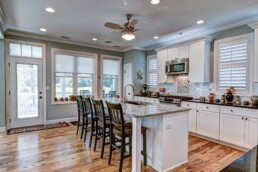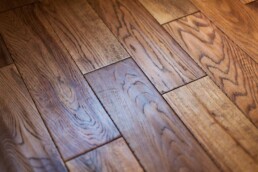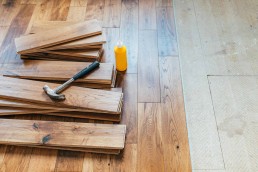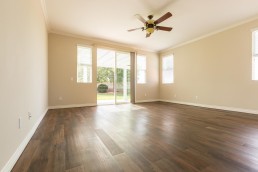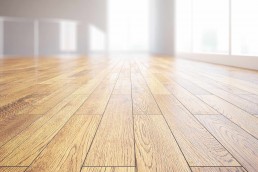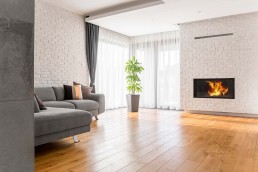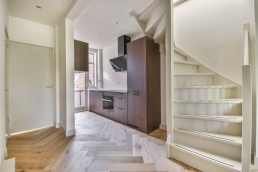Why Winter Is Hard on Hardwood Floors
Hardwood floors bring timeless beauty to a home, but they’re especially vulnerable during the winter season. Cold air, low humidity, and melting snow can all cause problems. Without preparation, you may notice gaps, scratches, or stains. Luckily, a few seasonal habits will keep your hardwood floors strong and stunning.
1. Manage Indoor Humidity
Wood expands in humidity and contracts when air is dry. In the winter, indoor air can dip below 30% humidity, causing boards to shrink and crack. Use a humidifier to maintain levels between 35–55%. This balance helps your hardwood remain stable and prevents gaps from forming.
2. Protect Against Water, Salt, and Slush
Snow and ice melt carried inside on boots can stain or warp hardwood. Place thick entry mats at every doorway, and add a boot tray for wet shoes. Wipe up puddles immediately before moisture seeps into seams. Salt crystals can scratch finishes, so frequent cleaning is essential.
3. Adjust Heating Practices
Direct heat from vents or space heaters can dry out wood faster. Redirect airflow away from your floors or use vent deflectors to keep warm air circulating evenly without damaging your hardwood.
4. Use Rugs and Runners Wisely
Area rugs in high-traffic spaces like hallways, mudrooms, and kitchens protect against heavy wear. Choose breathable pads under rugs so moisture isn’t trapped against your floors.
5. Clean With Care
Sweep or vacuum daily with a soft-brush attachment to capture salt and grit. For deeper cleaning, use a hardwood-specific cleaner—never steam mops or excessive water, which can cause permanent damage.
Bottom Line: With humidity control, moisture prevention, and proper cleaning, you can protect your hardwood floors through the winter months and enjoy their natural beauty year-round.
Fall Checklist: Protecting Your Hardwood Floors Before Winter
As the crisp fall air rolls in and the leaves start to turn, homeowners know one thing for certain—winter is coming. For those with hardwood flooring, the transition between seasons can take a toll if proper care isn’t taken. Between shifting humidity levels, wet boots, and road salt, hardwood floors face unique challenges this time of year.
The good news? With a few preventative steps, you can keep your hardwood floors looking stunning all season long. Here’s your fall checklist for protecting hardwood flooring before winter:
1. Control Indoor Humidity
Hardwood is a natural material that expands and contracts with changes in moisture. As the air dries out in fall and winter, floors can shrink, causing gaps between planks.
-
Aim to keep indoor humidity between 35–55%.
-
Use a humidifier once the furnace is running regularly.
-
Avoid drastic swings in temperature inside your home.
By maintaining steady conditions, you’ll extend the life and beauty of your hardwood flooring.
2. Protect Entryways from Moisture and Dirt
Autumn rains and winter snow bring water, mud, and debris indoors. All of these can dull or damage your hardwood floors.
-
Place high-quality floor mats at every entry.
-
Use boot trays to catch dripping shoes.
-
Sweep or vacuum regularly to prevent dirt and salt from scratching the surface.
Simple prevention at entryways is one of the most effective ways to protect hardwood flooring.
3. Check for Drafts and Seal Gaps
Cold drafts don’t just increase heating bills—they also dry out hardwood floors. Take time this fall to:
-
Seal any gaps around doors and windows.
-
Check baseboards for leaks where cold air can seep in.
-
Consider adding weather stripping to entry doors.
A tighter home helps regulate conditions for your hardwood flooring.
4. Refresh Your Finish
If your floors are looking dull, fall is the perfect time to give them new life before the heavy wear-and-tear of winter.
-
Use a hardwood flooring cleaner—never water and vinegar.
-
Apply a maintenance coat or polish if your finish is wearing thin.
-
For deep scratches or damage, consider scheduling a professional refinish.
A little care now prevents costly repairs later.
5. Use Rugs in High-Traffic Areas
Holiday gatherings and fall entertaining mean more foot traffic. Protect your floors by:
-
Laying down area rugs in dining rooms, hallways, and living rooms.
-
Choosing rugs with breathable pads designed for hardwood flooring.
-
Rotating rugs occasionally to ensure even wear.
Not only do rugs add warmth and style, but they also shield your hardwood floors from scratches and scuffs.
6. Schedule a Professional Inspection
If your hardwood floors are older, now is the time to bring in a professional. A flooring expert can:
-
Check for warping, loose planks, or finish issues.
-
Recommend seasonal maintenance.
-
Ensure your hardwood flooring is ready for the months ahead.
Final Thoughts
Your hardwood flooring is one of the most beautiful features of your home and one of the biggest investments. By following this fall maintenance checklist, you’ll protect your floors from seasonal damage and keep them looking their best through the holidays and beyond.
Whether you need a professional cleaning, refinishing, or even new hardwood installation, fall is the perfect time to act. Don’t wait until winter damage sets in—start protecting your floors today.
Hardwood Floors Stains: How to Pick the Perfect Tone for Your Space
When it comes to designing your dream home, few decisions have as much visual impact as the color of your hardwood floors. The right stain can dramatically transform a room — adding warmth, sophistication, or a sleek modern vibe. But with so many options available, how do you pick the perfect hardwood floor stain for your space?
In this guide, we’ll walk you through:
-
Popular stain color categories
-
Factors to consider when choosing a stain
-
Room-by-room suggestions
-
Pro tips for testing before you commit
Whether you're refinishing existing hardwood or installing new flooring, these insights will help you choose the best stain color to complement your home.
Popular Hardwood Floors Stain Colors
1. Natural and Clear Finishes
-
Look: Light, raw, and minimal
-
Best for: Small rooms or Scandinavian-style interiors
-
Works well on: White oak, maple
-
Pairs with: White walls, soft neutrals, light furniture
2. Warm Honey and Golden Tones
-
Look: Classic and cozy with a golden glow
-
Best for: Traditional, farmhouse, or rustic styles
-
Works well on: Red oak, pine
-
Pairs with: Earth tones, beige, and antique decor
3. Medium Browns
-
Look: Timeless and versatile with a rich undertone
-
Best for: Open-concept or transitional spaces
-
Works well on: Walnut, white oak
-
Popular stains: Provincial, Early American, Special Walnut
4. Dark Espresso and Mocha Tones
-
Look: Elegant and dramatic
-
Best for: Large spaces or contemporary styles
-
Caution: Can show dust, scratches, and pet hair
-
Pairs with: Bright whites, bold color schemes
5. Gray and Greige Tones
-
Look: Cool, modern, and urban
-
Best for: Coastal homes, modern condos, or lofts
-
Popular stains: Classic Gray, Weathered Oak
-
Works best on: White oak for an even finish
6. Custom and Mixed Stains
-
Look: Tailored and unique
-
Best for: Homeowners seeking a one-of-a-kind look
-
Note: Often involves blending multiple stains or water-popping techniques
How to Choose the Right Hardwood Floors Stain
Choosing a hardwood stain is about more than color preference — it’s about how the tone fits your space, lifestyle, and design goals. Consider the following:
1. Room Size and Natural Light
-
Light stains help small rooms feel larger and brighter
-
Dark stains add contrast but may make a space feel smaller
-
Use mid-tones to balance bright light or high ceilings
2. Wall Colors and Interior Design Style
-
Warm-toned stains pair well with creams, browns, and traditional décor
-
Cool-toned stains match modern, industrial, or coastal styles
-
Neutral stains allow flexibility if you change décor frequently
3. Wood Species
-
Different woods absorb stains differently
-
Red oak may pull red or pink tones
-
White oak offers a more neutral base for gray or cool tones
-
Maple and birch may absorb stain unevenly
4. Lifestyle and Maintenance
-
Dark stains tend to highlight scratches, dust, and pet hair
-
Lighter stains are generally easier to maintain
-
Matte finishes are more forgiving than glossy ones
Always Test Before You Stain
Never rely solely on sample boards or online images. Always test stains on your actual wood floor. Here's why:
-
Your wood’s grain, age, and type all affect stain absorption
-
Apply three to four test swatches in an inconspicuous area
-
View the samples in different lighting conditions throughout the day
-
Let the stain fully dry to see its final appearance
Tip: Water-popping the wood (applying water before staining) can intensify the color but will also make the wood more absorbent — test accordingly.
Room-by-Room Hardwood Floors Stain Suggestions
| Room | Recommended Stain Tone | Reason |
|---|---|---|
| Living Room | Medium or dark brown | Warm, inviting atmosphere |
| Kitchen | Natural or light brown | Bright, clean look; hides crumbs |
| Bedroom | Warm honey or greige | Calming, restful tone |
| Hallways | Light to medium tone | Conceals dirt and scuffs well |
| Basement | Mid-tone or gray (engineered) | Enhances low-light areas with a modern feel |
Final Thoughts: Matching Your Floors to Your Life
Your hardwood floor stain sets the tone for your entire space. Choosing the right color depends on more than just current trends — it's about how the tone complements your home’s lighting, layout, existing design, and how you live day to day.
By understanding the stain options and testing carefully, you’ll be able to achieve a look that enhances both the style and function of your space for years to come.
Need Help Choosing the Perfect Stain?
Our flooring experts offer personalized consultations and in-home sampling to help you find the ideal stain for your hardwood floors. Contact us today to schedule a visit or stop by our showroom.
How to Keep Your Hardwood Flooring Looking Good During Hot Summers
Summer heat can be brutal—not just for you, but for your hardwood flooring as well. With rising temperatures and increased humidity, summer can cause hardwood floors to expand, fade, or even warp if not properly cared for. Luckily, a few proactive steps can keep your hardwood floors looking beautiful and lasting for years to come.
Here’s how to protect your hardwood flooring from the summer heat.
1. Control Indoor Humidity
Wood is a natural material that responds to environmental changes. In high humidity, hardwood absorbs moisture, causing it to swell. In dry heat, it can contract and create gaps between planks.
Tip:
Invest in a humidifier and dehumidifier system to keep indoor humidity between 35% and 55%. Smart thermostats with humidity controls are a great way to monitor conditions year-round.
2. Keep Floors Cool and Covered
Prolonged exposure to direct sunlight can fade and discolor hardwood flooring, especially in rooms with large windows.
Tip:
Use curtains, blinds, or UV-blocking window films during peak sunlight hours. Consider adding area rugs in high-sunlight zones to protect the wood while enhancing your home’s aesthetic.
3. Clean Regularly and Wisely
Summer often means more outdoor activity, which can track dust, dirt, and moisture into your home—all of which can damage hardwood over time.
Tip:
Sweep or dry mop daily to remove grit. Use a damp mop weekly (not wet!) with a hardwood-safe cleaner. Avoid steam mops or excess water—they can cause long-term damage to wood floors.
4. Use Protective Pads and Rugs
Summer gatherings and kids home from school often lead to increased foot traffic and movement of furniture.
Tip:
Place felt pads under furniture and add rugs in busy areas like hallways and entryways. This prevents scratches and keeps your hardwood flooring looking flawless.
5. Maintain Proper Ventilation
Air circulation helps regulate temperature and moisture levels, reducing stress on your hardwood.
Tip:
Use ceiling fans and open windows in the cooler parts of the day. If you use air conditioning, make sure vents are unobstructed and filters are changed regularly to maintain air quality and circulation.
6. Schedule Professional Maintenance
If your floors are looking dull or worn despite regular care, it might be time for a professional touch.
Tip:
Have a hardwood flooring expert inspect and, if needed, recoat or refinish your floors. Summer is a great time to schedule maintenance when the air is dry and curing times are faster.
Final Thoughts
Keeping your hardwood flooring in top shape during summer doesn’t require a complete lifestyle change—just a little attention and regular care. By managing heat, humidity, and sunlight, you can enjoy gorgeous floors all year long.
Looking for professional help? Contact our team at Focus Flooring for expert hardwood flooring advice, refinishing, or new installations tailored to your home.
Engineered vs. Solid Hardwood Flooring: Which One Is Right for You?
When it comes to choosing hardwood flooring, one of the biggest decisions homeowners face is: engineered hardwood or solid hardwood? Both offer the timeless beauty of real wood, but they differ significantly in structure, performance, and cost.
In this guide, we’ll break down the key differences, pros and cons, and help you decide which option is best for your home.
What’s the Difference Between Solid and Engineered Hardwood?
-
Solid hardwood flooring is made from a single piece of real wood, typically ¾” thick. It can be sanded and refinished multiple times over its lifespan.
-
Engineered hardwood flooring consists of a thin top layer of real wood (called the veneer) bonded to multiple layers of plywood or HDF underneath. This construction makes it more stable, especially in areas with humidity or temperature fluctuations.
Pros and Cons of Solid Hardwood Flooring
Pros
-
Long lifespan – Can be refinished multiple times (up to 4–6 times).
-
Classic aesthetic – Deep grain and natural character.
-
Increases home value – Seen as a premium flooring option.
-
Custom stain options – Easily sanded and stained to match design trends.
Cons
-
Sensitive to moisture – Prone to expansion and contraction in humid environments.
-
Not recommended for basements or concrete slabs.
-
More expensive – Higher material and installation costs.
-
Installation limitations – Must be nailed or stapled down, not suitable for floating floors.
Pros and Cons of Engineered Hardwood Flooring
Pros
-
More stable – Less prone to warping and cupping, ideal for kitchens, basements, and over radiant heating.
-
Easier installation – Can be glued, stapled, or floated.
-
More affordable – Typically costs less than solid hardwood.
-
Wider plank options – More flexibility with sizes and finishes.
Cons
-
Limited refinishing – Depending on veneer thickness, may only allow 1–2 sandings.
-
Quality varies – Cheaper products may have thin wear layers.
-
Not as long-lasting – Typically has a shorter lifespan than solid wood.
Where to Use Solid vs. Engineered Hardwood
| Room/Condition | Best Choice |
|---|---|
| Dry, climate-controlled spaces (e.g., bedrooms, living rooms) | Solid Hardwood |
| Basements or areas with humidity | Engineered Hardwood |
| Over radiant heat systems | Engineered Hardwood |
| On concrete slab | Engineered Hardwood |
| Renovations with height restrictions | Engineered Hardwood |
| Historic home restorations | Solid Hardwood |
Sustainability Note
Engineered hardwood uses less slow-growing hardwood than solid planks, making it a more eco-conscious option when sourced responsibly. Look for FSC-certified products if sustainability is a priority.
Which Hardwood Flooring Is Right for You?
Choose solid hardwood if:
-
You want maximum longevity
-
You’re installing above grade in a dry area
-
You prefer traditional installation and design flexibility
Choose engineered hardwood if:
-
You need stability in variable climates
-
You’re renovating over concrete or radiant heating
-
You want a budget-friendly option that still uses real wood
Need Help Choosing the Right Hardwood?
Whether you're remodeling a single room or building your dream home, we can help you find the perfect flooring for your lifestyle and budget.
Contact us at Focus Flooring in Peterborough today to have one of our experts guide you to the right option for your project.
How to Protect Your Hardwood Floors from Muddy Paws This Spring
Spring brings sunshine, blooming flowers... and muddy paws.
If you have pets, you know the struggle is real — muddy footprints can quickly ruin the beauty and lifespan of your hardwood floors.
Don't worry! With a few smart tips, you can enjoy the season without stressing about damage.
In this guide, we’ll show you how to protect your hardwood floors from muddy paws this spring — and keep them looking flawless year-round.
1. Create a Pet Cleaning Station by the Door
Set up a small cleaning area near every entrance your pets use.
Stock it with:
-
A towel or microfiber cloth
-
A shallow water tray for rinsing paws
-
A pet-safe mat for wiping feet
Pro Tip: Teach your dog to "wait" while you clean their paws — it’ll save you tons of time (and mopping).
2. Invest in Durable Entryway Rugs
Entryway rugs are your first line of defense.
Look for rugs that are:
-
Waterproof or quick-drying
-
Non-slip to avoid accidents
-
Machine washable for easy cleanup
Best placement: Inside and outside every exterior door.
3. Use a Pet-Safe Floor Cleaner Regularly
Spring mud carries more than just dirt — it can hide salts, fertilizers, and chemicals that damage wood.
Clean floors frequently using a pH-neutral, pet-safe hardwood cleaner.
Avoid harsh chemicals like bleach or ammonia that can strip your floor’s finish.
4. Apply a Protective Sealant or Recoat
If your hardwood floors are due, spring is the perfect time to recoat.
A fresh layer of polyurethane protects against moisture, stains, and scratches.
Not sure if you need a new coat?
Try the water-drop test: If water soaks in quickly, it’s time!
5. Keep Pet Nails Trimmed
Long nails can dig into wood and cause scratches — especially when your dog runs excitedly inside after a walk.
Regular trimming (or professional grooming) keeps nails short, smooth, and floor-friendly.
Bonus: It’s healthier for your pet too!
Final Thoughts: A Little Prep Goes a Long Way
Protecting your hardwood floors from muddy paws this spring doesn’t have to be difficult.
With a smart cleaning routine, a few key supplies, and a little training, you can enjoy a clean, beautiful home — and happy pets.
The Ultimate Guide to Hardwood Flooring Care in Spring
As the winter frost melts away and spring takes over, homeowners should turn their attention to the maintenance of their hardwood flooring. Seasonal changes can have a significant impact on hardwood floors, and taking the right steps in spring can ensure their longevity and beauty. In this guide, we'll cover everything you need to know about hardwood flooring as we transition into the warmer months.
1. Watch Out for Seasonal Humidity Changes with Hardwood Flooring
Spring brings increased humidity, which can cause hardwood flooring to expand. If you notice slight swelling or gaps closing, don’t panic—this is a normal reaction to seasonal changes. However, too much moisture can lead to warping, so consider using a dehumidifier to maintain optimal indoor humidity levels between 30-50%.
2. Deep Clean your Hardwood Flooring After Winter
Winter can leave behind dirt, salt, and moisture that may have seeped into your hardwood floors. Spring is the perfect time for a thorough cleaning:
- Use a soft-bristle broom or vacuum with a hardwood floor attachment to remove dirt and debris.
- Mop with a damp (not wet) microfiber cloth and a pH-neutral hardwood floor cleaner.
- Avoid excessive water, as it can seep into the wood and cause damage over time.
3. Inspect for Any Winter Damage
Cold weather and heating systems can dry out hardwood flooring, potentially leading to cracks or separations. Take a close look at your floors for signs of damage and consider refinishing or sealing any problem areas to prevent further wear.
4. Protect Your Floors from Springtime Allergens
Spring means pollen, dust, and pet dander, which can settle into hardwood flooring crevices. To minimize allergens:
- Sweep and vacuum regularly.
- Use doormats at entryways to trap outdoor allergens before they reach your floors.
- Consider using an air purifier to reduce airborne particles that could settle onto hardwood surfaces.
5. Prepare for Increased Foot Traffic
With warmer weather, you may experience more foot traffic from guests, kids, and pets. To prevent scratches and dents:
- Place protective pads under furniture legs.
- Remove shoes at the door, especially high heels or cleats that can dent hardwood flooring.
- Consider adding stylish area rugs to high-traffic areas for added protection.
6. Refresh the Finish for a Seasonal Glow
If your hardwood flooring looks dull after winter, spring is a great time to rejuvenate its finish. Depending on the wear level, you can:
- Use a high-quality hardwood polish for a quick refresh.
- Recoat the floors with a new layer of finish if they show significant signs of wear.
- Schedule professional refinishing if deep scratches or dullness persist.
7. Open Windows with Caution
Fresh spring air is inviting, but open windows can also let in excess moisture and airborne debris that settle onto hardwood flooring. If you enjoy fresh air, balance it with proper ventilation and cleaning to prevent dust buildup and moisture-related issues.
8. Be Mindful of Pets and Spring Shedding
Pets tend to shed more as the seasons change. Loose fur and dirt can collect on hardwood floors, leading to scratches and buildup. Regularly groom your pets and clean floors with a soft microfiber mop to keep them in top shape.
Final Thoughts
Spring is a season of renewal, making it the perfect time to give your hardwood flooring the care it deserves. By managing humidity, cleaning thoroughly, and protecting against seasonal wear, you can keep your floors looking stunning year-round.
For more tips on hardwood flooring care or to explore top-quality hardwood options, visit our website or contact us today!
Incorporating Hardwood Flooring into Your Spring Projects
Spring is the perfect time to refresh your home, and one of the best ways to do that is by incorporating hardwood flooring into your renovation projects. Whether you're looking to upgrade a single room or transform your entire living space, hardwood floors add warmth, beauty, and value to your home. Here’s how you can seamlessly include hardwood flooring in your spring projects.
1. Refresh Your Living Room with Hardwood Flooring
The living room is the heart of the home, making it a great place to start your flooring upgrade. With the natural elegance of hardwood, you can create a cozy yet sophisticated atmosphere. Choose from a variety of wood species, stains, and finishes to match your aesthetic. Lighter woods like oak and maple bring an airy, open feel—perfect for the brightness of spring.
2. Upgrade Your Kitchen with Durable Hardwood Flooring
Many homeowners shy away from hardwood flooring in kitchens, but modern sealing techniques make it a durable and stylish choice. Hardwood provides a seamless transition from the kitchen to the dining or living area, enhancing the flow of your space. Opt for engineered hardwood flooring for better moisture resistance while maintaining the beauty of natural wood.
3. Create a Tranquil Bedroom Retreat
Spring cleaning often extends to the bedroom, and new hardwood flooring can completely transform your personal sanctuary. The warmth of hardwood flooring pairs beautifully with soft area rugs, giving your bedroom a comfortable yet elegant appeal. Consider wide-plank flooring for a modern, luxurious touch.
4. Enhance Your Entryway for a Lasting First Impression
The entryway sets the tone for your home, and hardwood flooring can make a stunning first impression. Durable and easy to clean, hardwood floors are ideal for high-traffic areas. Pair them with a stylish runner or seasonal décor to welcome guests with warmth and style.
5. Extend Hardwood Flooring to Your Home Office
With remote work becoming more common, upgrading your home office with hardwood floors can add both professionalism and comfort. Hardwood’s natural aesthetic boosts focus and productivity while providing a classic, polished look for virtual meetings.
Tips for a Smooth Installation
- Plan ahead: Schedule your flooring installation in advance to ensure availability during the busy spring season.
- Consider professional installation: While DIY is an option, hiring experts ensures a flawless finish and longevity.
- Choose the right wood type: Harder woods like hickory and oak are more resistant to scratches, making them great for high-traffic areas.
- Maintain properly: Use soft brooms, vacuum attachments, and wood-friendly cleaners to keep your floors looking pristine.
Final Thoughts
Spring is the season of renewal, and adding hardwood flooring to your home projects is an excellent way to enhance both aesthetics and functionality. Whether you're upgrading your living room, kitchen, bedroom, or entryway, hardwood floors offer timeless beauty and durability. Start planning today and enjoy the lasting benefits of elegant, high-quality flooring in your home!
Thinking of incorporating hardwood flooring this spring? Contact one of our flooring specialist to explore your options and get started on your dream renovation!
How to Use Hardwood Flooring in Your 2025 Renovations
How to Use Hardwood Flooring in Your 2025 Renovations: A Guide to Timeless Elegance and Durability
As we move into 2025, hardwood flooring continues to be a top choice for homeowners looking to elevate their home renovations. Whether you’re updating your kitchen, living room, or bedroom, hardwood flooring offers unmatched style, durability, and versatility. If you’re considering using hardwood flooring in your upcoming renovations, here’s how you can make the most of it to create a space that’s both timeless and functional.
Why Choose Hardwood Flooring for Your 2025 Renovations?
Before diving into specific ideas, let’s explore why hardwood flooring remains such a popular choice in 2025:
- Timeless Appeal: Hardwood flooring has been a classic choice for centuries, and it continues to be beloved for its natural beauty and warmth. As trends come and go, hardwood remains versatile and timeless, seamlessly complementing a range of interior styles.
- Durability and Longevity: One of the biggest advantages of hardwood floors is their long-lasting durability. Properly maintained hardwood can last for decades, making it a great investment for your home.
- Increase Home Value: Installing hardwood flooring can increase the value of your home. Potential buyers often favor homes with hardwood floors, knowing they offer a sophisticated, low-maintenance option.
- Sustainability: Many manufacturers offer eco-friendly options, with sustainably sourced hardwood that appeals to homeowners looking to reduce their environmental impact.
- Wide Range of Styles: From traditional oak to sleek walnut, there’s a wood species and finish for every taste. Whether you prefer light, airy tones or dark, rich hues, hardwood flooring offers versatility that other flooring options can't quite match.
Tips for Using Hardwood Flooring in Your 2025 Renovations
1. Consider the Latest Hardwood Flooring Trends
While hardwood flooring is timeless, there are always new trends to explore. In 2025, some of the standout trends for hardwood flooring include:
- Wide Planks: Wider planks continue to be a popular choice for modern homes. These large boards create a more open, airy feel, making them ideal for open-plan living areas or spacious rooms.
- Light Tones: Lighter wood finishes, such as ash, maple, or natural oak, are growing in popularity. These tones create a fresh, contemporary look and brighten up spaces.
- Matte Finishes: Matte and satin finishes have been rising in demand. They offer a more subtle sheen, which hides dust and scratches better than glossy finishes, making them great for high-traffic areas.
- Reclaimed Wood: Using reclaimed wood not only adds character and uniqueness to your home but also contributes to sustainability efforts. Many homeowners are opting for salvaged wood to give their renovations a rustic, vintage charm.
2. Choose the Right Hardwood for Each Room
Different rooms have different requirements, so it’s essential to choose the right type of hardwood flooring for each area of your home.
- Living Areas and Bedrooms: These spaces benefit from hardwood floors that showcase the natural beauty of the wood, like oak, maple, or cherry. These woods are durable, beautiful, and able to handle foot traffic while maintaining their look for years to come.
- Kitchens: Hardwood in the kitchen is a classic option, but consider using more durable species like hickory or walnut. To protect your floors from spills and stains, be sure to select a finish that is resistant to moisture.
- Bathrooms: While hardwood is not commonly recommended for bathrooms due to moisture exposure, you can still incorporate it by using engineered hardwood. This variation is more resistant to humidity and temperature changes.
3. Embrace a Blended Design with Other Materials
While hardwood is a standout material on its own, combining it with other materials can elevate your space even further. Consider pairing hardwood with:
- Tile: In bathrooms and kitchens, combine hardwood with sleek, modern tiles for an updated look.
- Stone: For entryways, living rooms, or even outdoor spaces, mixing hardwood with natural stone creates a sophisticated contrast.
- Area Rugs: If you have hardwood in your living or dining room, adding an area rug can help define the space while providing additional warmth and comfort.
4. Keep Maintenance in Mind
While hardwood floors are durable, they do require some maintenance to keep them looking their best. Here are a few tips for 2025 renovations:
- Regular Cleaning: Sweep or vacuum your hardwood floors regularly to remove dirt and debris. A microfiber mop can help remove any remaining dust without damaging the finish.
- Protect with Rugs and Mats: Place mats in high-traffic areas like entryways or under furniture to prevent scratches.
- Refinish Periodically: Over time, your hardwood floors may need to be refinished to restore their shine and remove any imperfections. Refinishing can be done every 7-10 years, depending on the level of foot traffic.
- Use Protective Pads: Attach felt pads to the bottom of furniture legs to prevent scratches when moving furniture around.
5. Consult a Professional for Installation
While some experienced DIYers may attempt installing hardwood themselves, it’s generally best to hire a professional for installation, especially if you’re using solid hardwood or intricate designs. Professionals will ensure the planks are installed correctly, minimizing gaps and maximizing the durability and aesthetic of the floor.
6. Incorporate Hardwood Flooring into Your Outdoor Spaces
With outdoor living spaces becoming increasingly important, you might consider using hardwood for decks or patios. Some types of hardwood are perfect for outdoor conditions when treated with the right sealants. This can help blend your indoor and outdoor spaces seamlessly, creating a harmonious flow in your renovation design.
Hardwood flooring is a versatile and timeless material that enhances both the functionality and beauty of any room. Whether you're renovating your kitchen, living room, or even your outdoor space, hardwood flooring offers numerous options for a durable, sustainable, and stylish upgrade. In 2025, embrace the trends while focusing on practicality, long-term value, and maintenance. When done correctly, hardwood floors will continue to add warmth and sophistication to your home for years to come.
So, as you plan your 2025 home renovations, make sure to consider how hardwood flooring can elevate your space and create a lasting impression.
The Timeless Allure of Hardwood Flooring: Why It’s Still the Top Choice for Homeowners
When it comes to flooring options, few materials rival the beauty and durability of hardwood. Whether you’re renovating your home or building a new one, hardwood flooring remains a top contender. In this blog, we’ll explore the benefits of hardwood flooring, popular types, maintenance tips, and why it continues to be a favorite choice for homeowners.
1. The Benefits of Hardwood Flooring
Aesthetic Appeal of hardwood flooring
Hardwood flooring adds an unparalleled elegance to any space. Its natural grain patterns and rich colors enhance the aesthetic of your home, making it warm and inviting. Plus, hardwood complements various design styles, from rustic to modern.
Hardwood Floorings Durability and Longevity
One of the standout features of hardwood flooring is its durability. When properly maintained, hardwood floors can last a lifetime, often outliving the homes they inhabit. This longevity makes them a cost-effective investment for homeowners.
Increased Property Value
Installing hardwood flooring can significantly increase your home’s resale value. Potential buyers often view hardwood floors as a premium feature, making your home more attractive on the market.
Eco-Friendly Choice
If sustainability is important to you, hardwood flooring is a great choice. Many hardwood options come from responsibly managed forests, and the production processes are becoming increasingly eco-friendly. Plus, hardwood is a renewable resource.
2. Popular Types of Hardwood Flooring
Solid Hardwood
Solid hardwood flooring consists of planks milled from a single piece of wood. This type is known for its durability and can be sanded and refinished multiple times, making it a long-lasting option.
Engineered Hardwood
Engineered hardwood features a top layer of real wood over a core of high-quality plywood. This construction makes it more resistant to humidity and temperature changes, making it ideal for basements or areas with fluctuating conditions.
Exotic Hardwoods
For those looking to make a statement, exotic hardwoods like Brazilian cherry or teak offer unique colors and grain patterns. While these options can be more expensive, their distinct appearance can add a touch of luxury to your space.
3. Maintenance Tips for Hardwood Flooring
Regular Cleaning
Keeping your hardwood floors clean is essential for longevity. Sweep or vacuum regularly to remove dirt and debris, and use a damp mop with a hardwood-specific cleaner to avoid water damage.
Protecting the Finish
Furniture pads and area rugs can help protect your floors from scratches and dents. Be mindful of high-traffic areas and consider applying a protective finish every few years to maintain the wood’s luster.
Humidity Control
Wood is sensitive to changes in humidity. Maintaining a consistent indoor humidity level (between 30-50%) will help prevent warping and cracking.
The Lasting Appeal of Hardwood Flooring
In a world filled with flooring options, hardwood flooring stands out for its beauty, durability, and timeless appeal. Whether you choose solid or engineered hardwood, you’re investing in a feature that enhances your home’s value and aesthetic. With proper care, hardwood floors can last for generations, making them a smart choice for any homeowner.
By prioritizing quality hardwood flooring in your home, you’re not just choosing a surface to walk on; you’re choosing a lasting investment that will enhance your living space for years to come. Ready to make the leap? Explore your options today and discover the difference hardwood can make!

